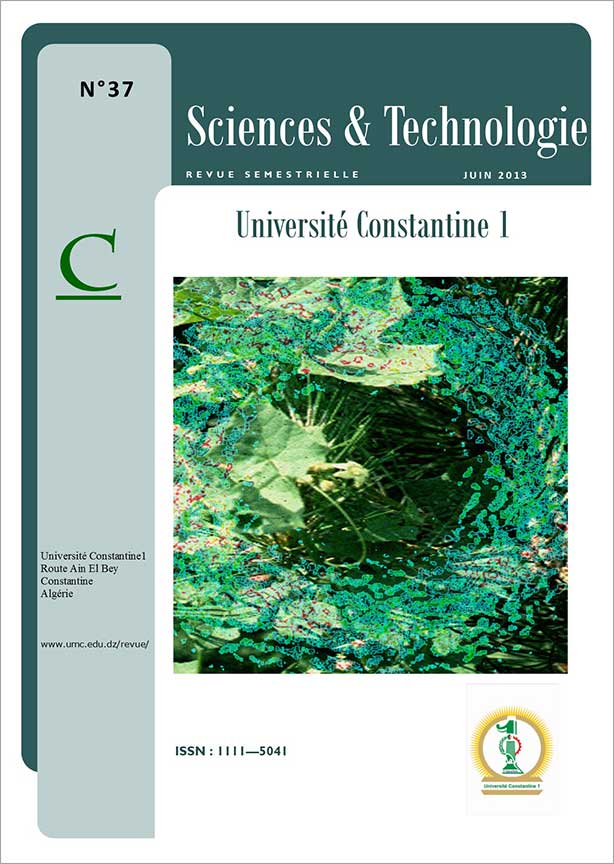CURETAGE DENTINAIRE : COMPARAISON in vitro DE L’EFFICACITE DE DEUX METHODES D’EVICTION DE DENTINE INFECTEE
Mots-clés :
Curetage dentinaire, dentine infectée, Méthode conventionnelle, Méthode au système carisolvRésumé
Depuis1908, l’éviction des tissus cariés, appelé curetage dentinaire, s’effectuait à l’aide d’instruments manuels (type excavateur) ou instruments rotatifs (fraises). Ce curetage mécanique rotatif, entraînait douleur, inconfort, dommages du complexe pulpo-dentinaire et des mutilations excessives du tissu sain dentaire. Ainsi, de nouvelles techniques d’élimination, ont été développées comme substitut ou alternative au fraisage. Le but de notre travail est d’évaluer l’efficacité de deux techniques d’éviction de dentine infectée : La méthode conventionnelle et le système carisolv. Pour cela, soixante dents (n = 60) fraîchement extraites, sont sélectionnées puis réparties en deux groupes (30 dents/ groupe/méthode) de façon aléatoire. Deux prélèvements de dentine infectée sont réalisés, le premier au centre de la lésion avant traitement, le second au fond de la cavité après traitement, afin d’estimer la composante bactérienne. Le temps de curetage dentinaire est mesuré au chronomètre, pour chaque dent et pour chaque type de méthode. Les résultats obtenus montrent des différences hautement significatives (p= 0,002) pour le Streptococcus et très hautement significatives pour les Lactobacillus sp (0,001) pour la méthode au fraisage, le système carisolv retrouve lui des différences très hautement significatives pour les deux espèces. Cependant, le temps réalisé pour le curetage dentinaire est court pour la méthode conventionnelle et très long pour le système carisolv.
Références
Lasfargues et Coll. Evolution des concepts en odontologie conservatrice du modèle chirurgical au modèle médical préventif. Information dentaire 1998, 8; 3111-24.
Colon. P, Kuhn.g, Domejean-Orliaguet.S. Evolution des concepts en odontologie restauratrice. Revue d’odonto-stomatologie, 2000 ; 29(4) : 173-178.
Fennich.m, Rida.S. Concepts actuels de préparation cavitaire. Faculté de Médecine dentaire de rabat.Université de mohamed suissi.2000.
Lasfargues J J et coll. Preservation tissulaire et traitement des lésions carieuses. Information dentaire.N° 32.25 sept 2002.
Auriol MM, Le CharpentierY, Le naour G. Histopathologie de la lésion carieuse de l’émail et la dentine. EMC (Paris) ; stomatologie/ odontologie, 22-007-A-10,2000
Piette E, Goldberg M. La dent normale et pathologique. Editeur de boech-université 2001.
Lager A, Thornqvit E, Ericson D .Cultivatable Bacteria in dentine after caries excavation using rose- bur or carisolv. Caries Res 2003;37:206-211.
Fusayama T, Terachima S .Differentiation of two layers of caries dentin by staining.J Dent Res 1972; 51: 866 (Abstract).
Kidd E.A.M., oyston-Bechal S, beighton D. The use of the caries detector dye during cvity preparation: a microbiological assessment.Br Dent J. 1993 Nov 6; 175(9): 312-3(Abstract).
Zacharia . M, Munshia. K. Microbiological assenssement of dentin stained with a caries detector dyes .J.Clin .Pedia. Dent 19: 111-15, 1995.
Kidd E.A.M. et al. Microbiogical validation of assessments of caries activity during cavity preparation. Caries Res. 27: 402-8, 19993.
McComb D. Caries-detctor dyes-how accurate and useful are they? J Can Dent Assoc 2000 Apr; 66(4):195-8.
Banerjee .A, Waston.T.F, Kidd.E.A.M. Dentine caries excavation : a review of current clinical techniques. British Dental Journal Volume 188. No.9 May 13, 2000.
Opsahhl-vital S, Belkheir C, Chaussain-Miller C, Lasfargue JJ. Traitement chimiomécanique des lesions carieuses: Indications cliniques sélectives. Information dentire 2004 ; N°32 ; 24 : 1567-1575.
Fusayama T, Terachima S .Differentiation of two layers of caries dentin by staining.J Dent Res 1972; 51: 866 (Abstract).
HarniratisaiM, InokoshiS, Shimada Y and al. Interfacial morphology of an adhesive composite resin and etshed carie-affected dentin. Oper Dent 1992; 17: 222-223.
Benrerjee A 1998. Applications of scanning microscopy in the assessment of dentine caries and methods for its removal Ph.D. Thesis. University of London, London,England.
Splieth C, Rosin N, Gellissen B. determination of residual dentine caries after conventional mechanical and chemomechanacal caries removal with carisolv. Clini Oral invest 5:250-253. 2001.
Bowden G.H. Which bacteria are cariogenic in humain ?. In : N. W.Johnson, Editor, Risk markers for Oral diseases. Vol 1: dentalCaries, univesity press. Combredge (1990), pp. 266-228.
Van Houte. J. Role of micro-organisms in caries etiology. J Dent Res 1994; 7: 87-96.
Moore We, Moor L.V.H. The bacteria of periodontal diseases. Periodontol 2000 1994;5: 66-77.
Nyvad B, kilian M. Microflora associated with experimental root surface caries in humans. Infect Immun 1990; 58: 1628-1633.
Ozaki K, Matsua T, Nakae Hand al. A quantitative comparison of selected bacteria in human carious dentine by microscpic. Caries Res.1994; 28(3):137-45.
Lager A , Thornqvit E, Ericson D .Cultivatable Bacteria in dentine after caries excavation using rose- bur or carisolv. Caries Res 2003;37:206-211.
Azrak. B, Callaway. A, Grundheber. A and al. Comparison of the efficacy of chemomechanical caries removal( Carisolv) wth that of conventional excavation in reducing the cariogenic flora. International journal of Paediatric dentistry 2004; 14: 182-191.
Weerheijm KL, Kreulen CM, de Soet JJ, Groen HJ, van Amerongen WE. Bacterial counts in carious dentine under restorations: 2-year in vivo effects. Caries Res. 1999;33(2):130-4.
Yazici. A.R, Attilla.P , Özgünaltay.G and al. In vitro comparison of the efficacy of carisolv and conventional rotary instrument in caries removal. J Oral Rehabil 2003 Dec; 30(12): 1177-82.
Ericson .D, Zimmerman. M, RAbert. H and al. Clinical evaluation of efficacy and safety of a new method for chemo-mechanical removal of caries. Caries Res.1999;33:171-177.
Banerjee .A, Kidd ;E.A.M, Waston.T.F. Scanning electron microscopic observations of human dentine after mechanical caries excavation. Journal of dentistry 28 (2000) 179-186.
Fure S, lingstrom P, birkhed D. Evaluation of carisolv for the chimo-mechanical removal of primary root caries in vivo. Caries res 2000; 34(3): 275-80.
Munshi, A.K., Hegde, A.M.& Shetty, P.K. (2001) Clinical evaluation of carisolv in the chemo- mechanical removal of carious dentin. Journal of clinical Pediatric Dentistry, 26,49.
Maragagakis G.M., Hahn P.& Hellwig E. (2001) Clinical evaluation of chemo-mechanical caries removal in primary molars and its acceptance by patients. Caries Research, 35(3): 205-10.
Nadanovsky. P, Cohen Carneiro. F, Sousa de mello.F. Removal of caries using only hand instruments : A comparaison of mechanical and chemo-mechanical methods. Caries Res 2001; 35;384-389.

